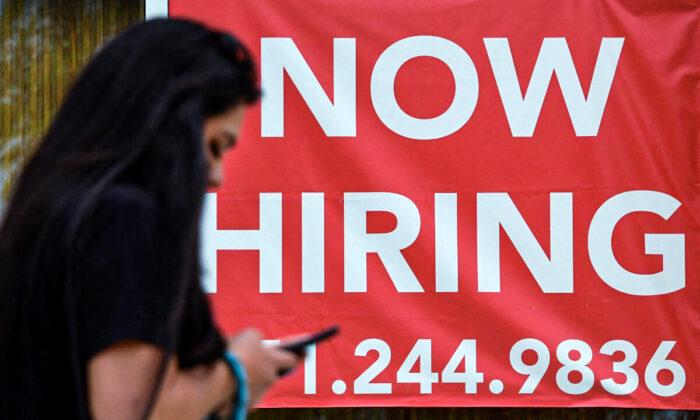New weekly filings for unemployment insurance—a proxy for layoffs—have risen above analysts’ expectations to a three-month high, prompting some economists to question whether the tight labor market is heading for a softer patch.
Jobless claims hit a low of 166,000 in the week of March 19 and this week’s uptick puts them around 22 percent higher.
Some analysts have raised the prospect of a slow but steady deterioration in the labor market as surging inflation has forced the Fed into a tightening cycle as economic growth softens.
Booth has been warning of signs the U.S. economy could be tipping into a recession, pointing to a softening in recent U.S. manufacturing data, including inventories growing at slower rates.
“By all accounts, the discussion should be segueing from industrial recession to broad-based & full-blown economic contraction,” she added.
The overall ISM manufacturing index in April came in at 55.4 percent, a drop of 1.7 percentage points from the prior month. Readings above 50 indicate expansion.
“Manufacturing performed well for the 23rd straight month, with demand registering slower month-over-month growth (likely due to extended lead times and decades-high material price increases) and consumption softening (due to labor force constraints),” Timothy Fiore, chair of the ISM Manufacturing Business Survey Committee, said in a statement.
Still a Source of Strength
Some analysts note that Thursday’s jobless claims number is close to a historic low and there are signs that the labor market remains strong.“Broadly speaking, the job market is still a source of strength in an economy riddled with worries about inflation, higher interest rates, and more,” Bankrate senior industry analyst Ted Rossman told The Epoch Times in an emailed statement.
“Historically speaking, this figure (203,000) is still quite low. It’s probably unrealistic to expect it to fall much below 200,000,” Rossman added.
Prior to the pandemic, initial jobless claims were running at around the 210,000 per week mark, on average.
Other data in Thursday’s unemployment claims report suggests the labor market remains tight. Continuing jobless claims, which run a week behind the initial filings figure and reflect the total number of people receiving benefits through traditional state programs, fell by 44,000 to 1.343 million, the lowest since 1970.
“Continuing claims fell to their lowest level in 52 years, indicating that bouts of unemployment are generally short-lived these days,” Rossman said.
Beginning of the End?
Economist Fabian Wintersberger questioned whether Thursday’s jobless claims number signals “the beginning of the end of the ’tight labor market,'” adding in a tweet that part of the story behind the labor market tightness is due to a low labor force participation rate, rather than economic fundamentals.It’s a theme expounded on by economist Daniel Lacalle, who told The Epoch Times in an emailed statement that, “the U.S. labor market tightness is more political propaganda than reality.”
“In March, the labor force participation rate was 62.4 percent and employment to population ratio was 60.1 percent. Both have been stagnant for almost a year and both remain below their February 2020 levels (63.4 percent and 61.2 percent),” he said.
“So the labor market is far from recovered, which explains why median wage growth is so poor,” Lacalle added.
In April, the U.S. labor force participation rate declined to 62.2 percent, while nominal month-over-month wage growth slowed to 0.3 percent, down from 0.4 percent in March.
Nominal wages, which are not adjusted for inflation, climbed by 5.5 percent in the year through April, but the faster 8.3-percent pace of consumer price growth means that inflation-adjusted real wages actually declined 2.8 percent.





